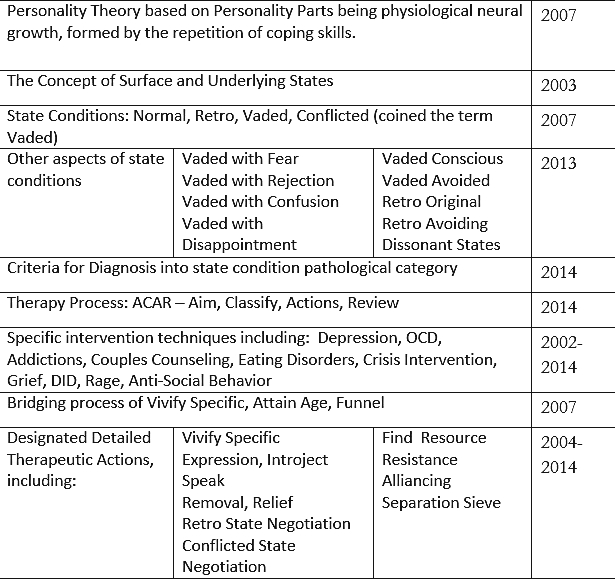From Gordon Emmerson: I called myself an Ego State Therapist for many years, and I have written a number of books and articles on my conception of the personality from an Ego State perspective. I spent a summer with John and Helen Watkins in Missoula Montana in 2000, which was very meaningful to me. I had just finished a draft of my first book, Ego State Therapy (2003, 2006, 2010). They were welcoming, generous and lovely, and very much in love. On a few occasions Jack would be praising Helen, she would stop him, and say to me, “The problem with Jack is, he just loves me too much.”
Jack knew my work was moving away from his, and he said the therapy would evolve and he saw that as a good thing. He had been frustrated that the Psychoanalytic community had not adopted his improved techniques for change, and that is why he and Helen established Ego State Therapy. They saw it as the best way they could get their word out, and it needed to be heard.
It is for this same cause I started Resource Therapy.
There are three core reasons I moved from EST. My sincere belief is RT effectively assists clients and therapists globally.
They are:
- Resource Therapy uses no hypnotic inductions, therefore significantly more therapists can be trained, and more clients can benefit.
- In Resource Therapy Introjects are viewed as non-personality parts, and a Resource State can become empowered with this understanding.
- The term Resource is a positive and accurate description of a personality part. Clients and therapists can understand and relate to it.
I have been teaching and developing parts techniques for a number of years. I find that hypnotic induction is not needed for clients to gain benefit from the approach.
My second book, Advanced Skills and Interventions in Therapeutic Counseling (2007), which I wrote as a text while teaching Master’ Counseling Classes at university, was dedicated to showing how states could be worked with when no hypnotic induction was used. John Watkins commented, Emmerson shows how to activate and work with covert states without inducing hypnosis. This is a significant contribution to the entire field of psychotherapy (inside cover, Advanced Skills, and Interventions in Therapeutic Counseling, (2007).
RT Theoretical and Technique Developments by Gordon Emmerson

The technique regimens presented in Resource Therapy require no hypnotic inductions, and they show amazing results.
I want the techniques I have developed to be readily available to all therapists, and not just for those who have studied hypnosis. Traditionally Ego State Therapy study requires hypnosis training prior to the study.
Secondly, a core part of my techniques is the conception of Introjects as being, Internal impressions held by Resource States. They are owned by our states and they have only the power our states give them. E.g., I am in a Resource State now and if while in this state I meet a person, my state will introject an impression of that person and hold it. The introjection of that person by my current Resource State is an ‘Introject’. It is merely an impression. It is not a real person, may not be an accurate representation of the real person, and consists only of the impression held by the state that introjected it. This is core to my whole process of Resource Therapy.
When Introjects are understood in this way, the Resource State is seen as having power over the Introject. The Resource State owns the Introject. A Resource State may carry fear of a ‘Bad Guy’ from the past. The understanding that the ‘Bad Guy’ really does not exist now, and is merely an impression from the past, allows the therapist and Resource State to ‘shrink’ the ‘Bad Guy’ Introject, and express to it fully, “You no longer exist, and you have no power here.” In this manner, a Resource State that carried fear can change its internal impression of the ‘Bad Guy’ from big and scary to little and powerless. The state that carried fear becomes empowered and feels safe (see RT Actions 4-7).
Conversely, many Ego State therapists see Introjects as real personality parts that must be worked with to change. By establishing Resource Therapy, the definition of Introjects and the core associated therapeutic responses to them can be clarified.
Thirdly, the term, Resource Therapy, gives the correct connotation that our parts are our resources. Too often clients and therapists have thought that Ego State Therapy was a therapy about how big someone’s ego was.
A resource is something that can be useful. That is exactly what personality parts are.
When they are healthy and when they are Conscious at the right time we function optimally. The title ‘Resource Therapy’ will allow the therapy to grow more easily and be better understood by both therapists and clients.
I have great respect for Ego State Therapy.
I hope the therapy continues to grow and develop. There is an important place for it within the hypnosis community.
Because I believe the theories and techniques I have developed can move forward better as Resource Therapy I have chosen to use that title.
I invite others, from any therapeutic orientation, to use the technique regimens that have been developed for Resource Therapy, including the diagnostic categories and the RT Actions.
Edited Excerpt is taken from Appendix 2: Resource Therapy (2014) by Professor Gordon Emmerson. PhD
